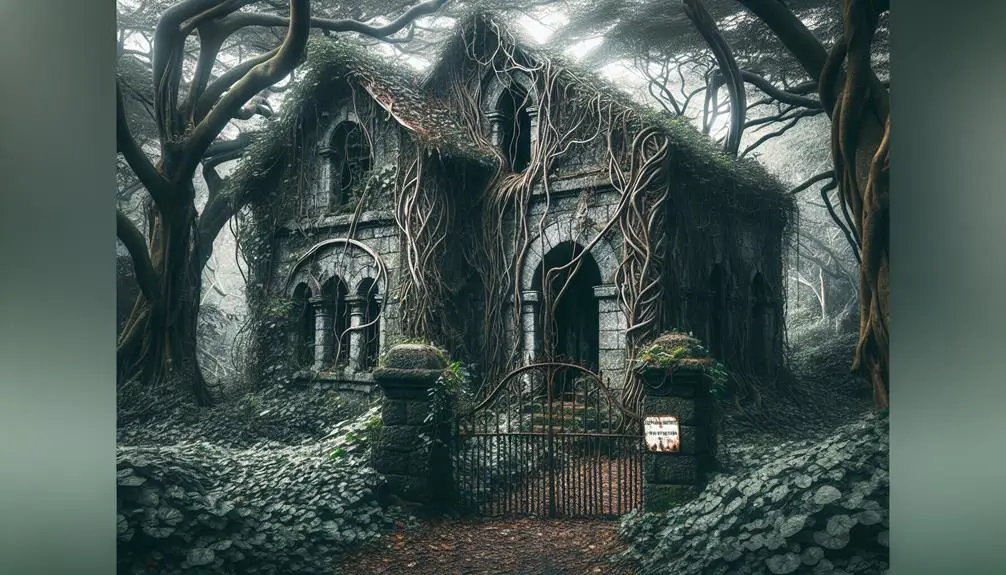When exploring colonial ghost town remnants, remember to study architectural preservation and historical artifacts to uncover the past. Utilize metal detectors and explore abandoned structures while staying safe – wear appropriate gear, carry supplies, and respect the environment. Document each artifact meticulously for preservation using images and precise location recording. To safeguard colonial ghost town legacies, involve the local community, historians, and preservationists for conservation efforts. Learn how to navigate these fascinating remnants for a truly enriching experience.
Key Points
- Prioritize safety precautions to ensure personal well-being.
- Wear appropriate gear and carry essentials like water and first aid.
- Respect artifacts by avoiding removal or damage.
- Heed warning signs for unsafe areas in ghost towns.
- Stay informed about historical research and map out exploration plans.
Understanding Colonial Ghost Town History
Delving into the history of colonial ghost towns reveals a complex tapestry of settlement patterns, economic dynamics, and social structures that shaped these once-thriving communities. The historical significance of these ghost towns lies in their ability to provide a glimpse into the past, showcasing the architectural preservation of a bygone era. Each building, street layout, and artifact holds valuable clues about the lives of the people who inhabited these now-abandoned places.
Understanding the historical significance of colonial ghost towns goes beyond mere curiosity; it allows us to appreciate the ingenuity and resilience of those who built these settlements. By exploring the architectural preservation of these towns, we can gain insight into the craftsmanship and design principles of earlier times. Studying the layout of houses, storefronts, and public buildings provides a window into the daily lives and social interactions of the past.
Preserving these architectural remnants is important for maintaining a connection to our collective history. By recognizing the significance of architectural preservation in colonial ghost towns, we make certain that future generations can continue to learn from and appreciate the legacy of these once-thriving communities.
Locating Hidden Ghost Town Treasures
Uncovering hidden treasures within colonial ghost towns requires a meticulous and systematic approach to exploration and discovery. To successfully locate these elusive gems, employing effective treasure hunting techniques and utilizing historical research methods are essential.
Begin by delving into historical records, maps, and archives to gain insights into the town's past. Look for clues about potential treasure locations, such as old mining sites, abandoned buildings, or areas of significant historical importance.
Once armed with historical context, employ on-site treasure hunting techniques like metal detecting, scanning the ground with a metal detector to uncover buried artifacts and valuables. Pay attention to subtle changes in the terrain, as they could indicate hidden caches or structures beneath the surface.
Additionally, explore abandoned structures and underground passages cautiously, as they often hold valuable items left behind by previous inhabitants.
Exploring Ghost Town Remnants Safely
Exploring colonial ghost town remnants safely requires a thorough understanding of potential hazards and a strategic approach to traversing the terrain. When engaging in urban exploration within these historical sites, it's important to prioritize safety precautions. Always wear appropriate footwear and clothing, as the remnants may contain sharp objects or unstable structures. Additionally, carry a first aid kit and sufficient water in case of emergencies.
To guarantee historical preservation and respect the archaeological significance of these sites, it's vital to refrain from removing or damaging any artifacts. Take only photographs and leave only footprints to maintain the integrity of the ghost town remnants for future explorers. As you navigate the terrain, be mindful of signs warning of unsafe areas and abide by them to avoid accidents.
Documenting Colonial Era Artifacts
When documenting colonial era artifacts found within ghost town remnants, meticulous attention to detail is paramount for preserving historical accuracy and cultural significance. Utilizing archaeological techniques can help uncover valuable insights into the lives of past inhabitants. To guarantee proper artifact preservation, follow these essential tips:
- Cataloging: Create a detailed inventory of each artifact, noting its location, condition, and any associated findings.
- Photography: Capture high-quality images from multiple angles to document the artifact in its original state before removal.
- Mapping: Record the exact location of each artifact within the site to maintain spatial relationships critical for interpretation.
- Labeling: Use non-invasive methods like small tags or markers to label artifacts, ensuring they remain identifiable throughout the documentation process.
Preserving Colonial Ghost Town Legacies
Preservation strategies for Colonial Ghost Town legacies require a holistic approach that integrates conservation, interpretation, and community engagement. To uphold the historical significance of these sites, employing effective preservation techniques is paramount. Conservation efforts should focus on stabilizing structures, protecting artifacts, and preventing further deterioration. Implementing proper documentation methods is essential to guarantee the accurate preservation of historical materials and structures.
Community engagement plays a pivotal role in preserving Colonial Ghost Town legacies. Involving local residents, historians, and preservation experts fosters a sense of shared responsibility and promotes sustainable conservation practices. Interpretation of the historical context is essential in conveying the significance of these ghost towns to visitors and future generations. Utilizing signage, guided tours, and educational programs can help contextualize the historical importance of these sites.
Frequently Asked Questions
Are There Any Specific Regulations or Laws Governing the Exploration of Colonial Ghost Town Remnants?
Exploring colonial ghost town remnants is like unraveling a mystery in a forgotten book. When it comes to regulations, respect historical preservation laws, ensuring your adventure leaves a positive impact on these historical treasures.
How Can I Differentiate Between Genuine Colonial-Era Artifacts and More Recent Items Left Behind in Ghost Towns?
To differentiate between genuine colonial-era artifacts and recent items in ghost towns, consider historical context. Look for signs like material quality, craftsmanship, and design styles. Pay attention to details and consult experts or historical records for validation.
Are There Any Superstitions or Local Legends Associated With the Ghost Towns That I Should Be Aware Of?
Local legends and superstitions add depth to ghost towns. Be mindful of tales passed down, as they hold historical significance. Preservation efforts often tie in with these narratives. Archaeological findings may shed light on these myths.
What Are Some Common Misconceptions About Colonial Ghost Towns That I Should Be Cautious Of?
When exploring colonial ghost towns, be cautious of misleading myths and misconceptions. Preservation practices aim for historical accuracy and cultural significance. Stay informed to appreciate these remnants without falling for common misconceptions.
How Can I Respectfully Interact With Any Descendants or Local Communities Associated With the Ghost Town Remnants?
When interacting with descendants or local communities tied to ghost town remnants, always prioritize respect and cultural sensitivity. For instance, engaging in open dialogue, listening actively, and acknowledging their history can foster meaningful connections and mutual understanding.



